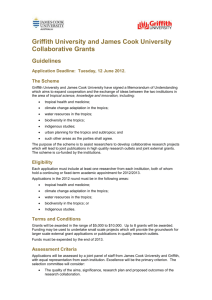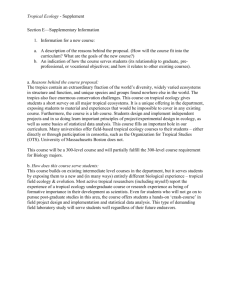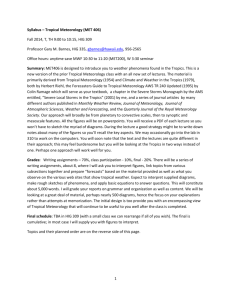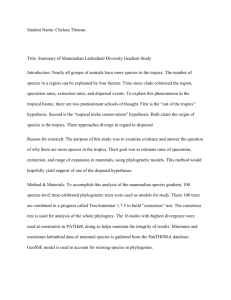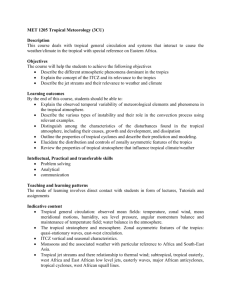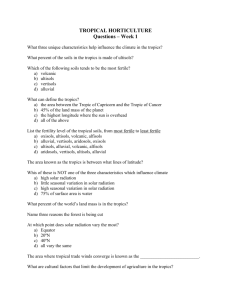Geography_WS2_GEO11_TropicalLandforms.Smt1.1011
advertisement
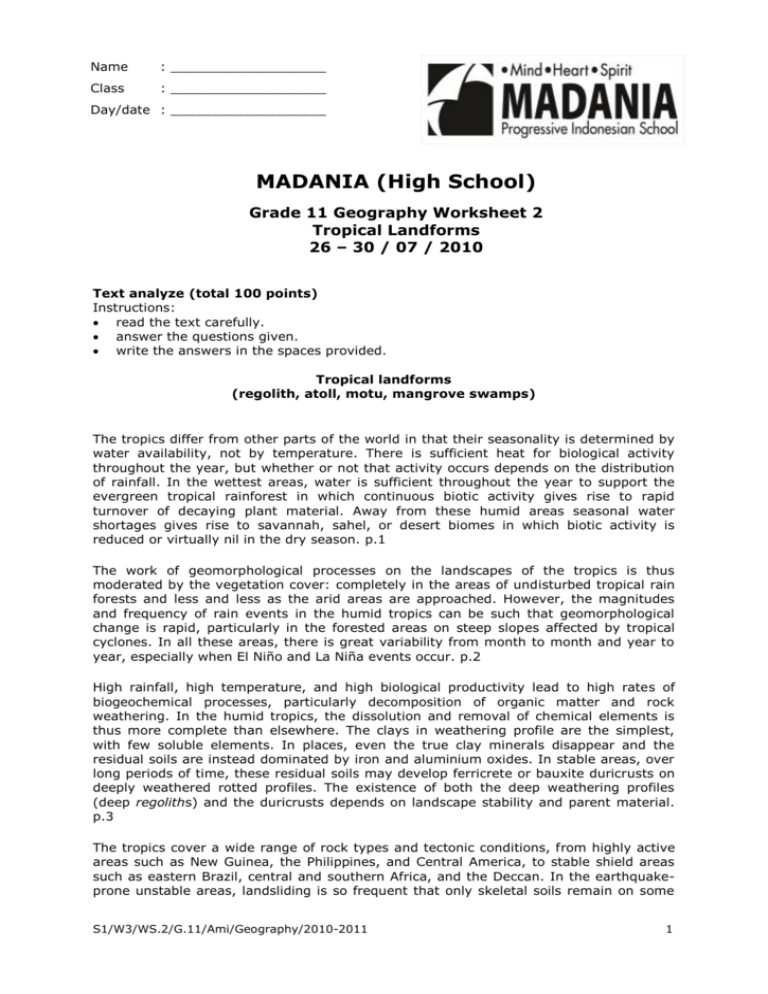
Name : ___________________ Class : ___________________ Day/date : ___________________ MADANIA (High School) Grade 11 Geography Worksheet 2 Tropical Landforms 26 – 30 / 07 / 2010 Text analyze (total 100 points) Instructions: read the text carefully. answer the questions given. write the answers in the spaces provided. Tropical landforms (regolith, atoll, motu, mangrove swamps) The tropics differ from other parts of the world in that their seasonality is determined by water availability, not by temperature. There is sufficient heat for biological activity throughout the year, but whether or not that activity occurs depends on the distribution of rainfall. In the wettest areas, water is sufficient throughout the year to support the evergreen tropical rainforest in which continuous biotic activity gives rise to rapid turnover of decaying plant material. Away from these humid areas seasonal water shortages gives rise to savannah, sahel, or desert biomes in which biotic activity is reduced or virtually nil in the dry season. p.1 The work of geomorphological processes on the landscapes of the tropics is thus moderated by the vegetation cover: completely in the areas of undisturbed tropical rain forests and less and less as the arid areas are approached. However, the magnitudes and frequency of rain events in the humid tropics can be such that geomorphological change is rapid, particularly in the forested areas on steep slopes affected by tropical cyclones. In all these areas, there is great variability from month to month and year to year, especially when El Niño and La Niña events occur. p.2 High rainfall, high temperature, and high biological productivity lead to high rates of biogeochemical processes, particularly decomposition of organic matter and rock weathering. In the humid tropics, the dissolution and removal of chemical elements is thus more complete than elsewhere. The clays in weathering profile are the simplest, with few soluble elements. In places, even the true clay minerals disappear and the residual soils are instead dominated by iron and aluminium oxides. In stable areas, over long periods of time, these residual soils may develop ferricrete or bauxite duricrusts on deeply weathered rotted profiles. The existence of both the deep weathering profiles (deep regoliths) and the duricrusts depends on landscape stability and parent material. p.3 The tropics cover a wide range of rock types and tectonic conditions, from highly active areas such as New Guinea, the Philippines, and Central America, to stable shield areas such as eastern Brazil, central and southern Africa, and the Deccan. In the earthquakeprone unstable areas, landsliding is so frequent that only skeletal soils remain on some S1/W3/WS.2/G.11/Ami/Geography/2010-2011 1 sandstones and mudrocks. Weathering profiles here are rarely more than 2 m deep, whereas more than 120 m of regolith occur at places in Africa and Australia. These elements provide a fundamental contrast of tropical landscapes, from the landslide-prone steep and dense valley networks of the feral relief of New Guinea and parts of Central America to the old, deeply weathered plains of stable shield areas. This contrast was expressed at the beginning of the twentieth century in the writings of the pioneer German geomorphologists, Behrmann in New Guinea and Thorbecke in East Africa. Contrasts of this type can be found within relatively short distances. Much of the island of Borneo is made up of cuestas of Tertiary sandstones with intervening areas of weak mudstones within shallow weathering profiles, but in the west of the island the igneous rocks of the Thai–Malay Peninsula and Bangka and Billiton Islands Mesozoic intrusions occur, with deep weathering profiles on the granites. Landform evolution in the tropics is dominated by these spatial variations in conditions and by the way that conditions have changed during the Quaternary. p.4 Landforms in the tropics are an expression of the balance between rate of rock rotting and the formation of regolith on the one hand, and the rate of removal and subsequent deposition of these products of weathering on the other. Overall, the landforms are governed by the interrelationships between climate, lithology, and past landscape history. Few landforms can be said to be uniquely tropical, because the weathering and transport processes associated with running water are found in other climates, but some are much more likely to be found in the tropics and others evolve more completely in the tropics. The more complete development may be due to the continuous landform evolution and fluvial conditions that have taken place, not only through the Quaternary, but probably through much of the Tertiary in some of the stable shield areas of tropical regions. The Quaternary may have produced fluctuations in moisture regimes, with periods of longer or shorter dry seasons, but basically the dominant landform processes were related throughout the time to chemical weathering and the work of running water. Such continuity is a dominant force over about 70 per cent of the tropics, which have escaped orogenic activity since the early Tertiary. This has meant that large areas of the tropics are covered by extensive plains, of relatively low relief with relatively deep regolith cover. Such plains exist outside the tropics, particularly in the continents of the southern hemisphere and in parts of the northern hemisphere, but some scholars argue that they were the product of evolution under early warm, palaeotropical climates in the early Tertiary. They are not, however, uniquely tropical. p.5 Only two types of landform—the coral reefs and the mangrove swamps—are uniquely tropical and even the latter can be found outside tropical latitudes along the coasts of New South Wales and the North Island of New Zealand. They are both biogenic landforms resulting from biotic activity regulated by temperature and salinity. p.6 The shores of continental mainlands and many islands in the tropics are fringed with reefs or other formations built of the bodies of coral polyps, tiny marine animals that secrete external skeletons of calcium carbonate. The polyps live in shallow tropical waters and can build up reef formations on any stable coastal platform or substrate. The coral reefs of the Bahamas and southern Florida are built on such a platform. The Australian Great Barrier Reef is a huge complex of many individual reefs, irregular coral masses, and some islands on a shallow bedrock platform. p.7 In the oceans, characteristic fringing reefs develop around the volcanic islands surmounting hot spots, as in Hawaii, or the mid-oceanic ridges. When a volcano first grows up to the ocean surface, a reef may become established. If later the volcano sinks, the reef may continue to build on itself, growing upwards just below the sea surface until it forms a barrier reef some distance out from the volcanic island. Further subsidence of the volcano may leave only the coral reef above the sea surface, forming an atoll. The term ‘atoll’ implies a ring-shaped structure. However, a perfect ring rarely S1/W3/WS.2/G.11/Ami/Geography/2010-2011 2 occurs. An atoll usually consists of a string of closely spaced coral islets separated by narrow channels of water. Each individual islet is called a motu. p.8 Mangrove swamps are the tropical equivalent of coastal salt marshes. Mangroves tend to occur equatorwards of 30° in the northern hemisphere, and from slightly higher latitudes in the southern hemisphere, with salt marshes towards the poles. Mangroves develop at river delta fronts, as in the case of the Sundarbarns of Bengal and Bangladesh, and along major river estuaries, as in Auckland and Sydney harbours, or behind coastal barriers, as on the north of Borneo. Most importantly, they form extensive prograding areas along sheltered coasts, as on the sides of the Malacca Straits between Sumatra and the Malay Peninsula. p.9 (retrieved from http://science.jrank.org/pages/48226/tropical-landforms.html">tropical landforms - regolith, atoll, motu, Mangrove swamps, inselbergs, etchplanation) 1. Write the main idea of each paragraph. (90 pts) ____________________________________________________________________ ____________________________________________________________________ ____________________________________________________________________ ____________________________________________________________________ ____________________________________________________________________ ____________________________________________________________________ ____________________________________________________________________ ____________________________________________________________________ ____________________________________________________________________ ____________________________________________________________________ ____________________________________________________________________ ____________________________________________________________________ ____________________________________________________________________ ____________________________________________________________________ ____________________________________________________________________ ____________________________________________________________________ ____________________________________________________________________ ____________________________________________________________________ ____________________________________________________________________ ____________________________________________________________________ ____________________________________________________________________ ____________________________________________________________________ ____________________________________________________________________ ____________________________________________________________________ ____________________________________________________________________ ____________________________________________________________________ ____________________________________________________________________ S1/W3/WS.2/G.11/Ami/Geography/2010-2011 3 2. Explain what makes the tropics differ from other parts of the world. (10 pts) ____________________________________________________________________ ____________________________________________________________________ ____________________________________________________________________ ____________________________________________________________________ ____________________________________________________________________ ____________________________________________________________________ ____________________________________________________________________ ____________________________________________________________________ ____________________________________________________________________ ____________________________________________________________________ ____________________________________________________________________ S1/W3/WS.2/G.11/Ami/Geography/2010-2011 4

